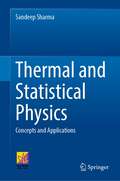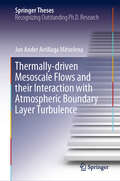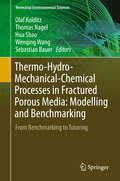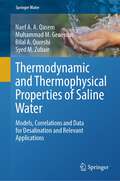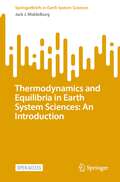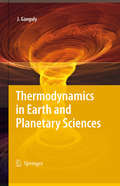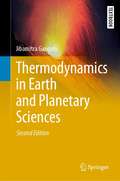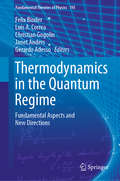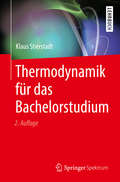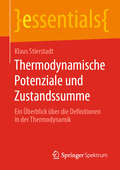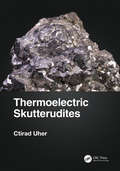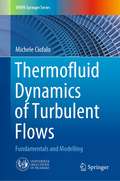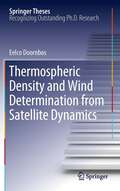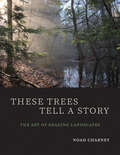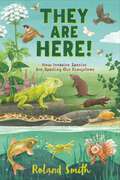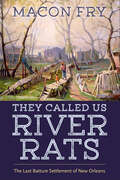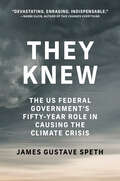- Table View
- List View
Thermal and Statistical Physics: Concepts and Applications
by Sandeep SharmaThis textbook presents the fundamental concepts and theories in thermal physics and elementary statistical mechanics in a very simple, systematic and comprehensive way. This book is written in a way that it presents the topics in a holistic manner with end-of-chapter exercises and examples where concepts are supported by numerous solved examples and multiple-choice questions to aid self-learning. The textbook also contains illustrated diagrams for better understanding of the concepts. The book will benefit students who are taking introductory courses in thermal physics, thermodynamics and statistical mechanics.
Thermally-driven Mesoscale Flows and their Interaction with Atmospheric Boundary Layer Turbulence (Springer Theses)
by Jon Ander Arrillaga MitxelenaThis book presents developments of novel techniques and applies them in order to understand the interactions between thermally driven mesoscale flows (sea and mountain breezes) and the turbulent exchange within the atmospheric boundary layer. These interactions are not accurately reproduced in the meteorological models currently employed for weather forecasting. Consequently, important variables such as air temperature and wind speed are misrepresented. Also, the concentrations of relevant greenhouse gases such as CO2 are considerably affected by these interactions.By applying a systematic algorithm based on objective criteria (presented here), the thesis explores complete observational databases spanning up to 10 years. Further, it presents statistically significant and robust results on the topic, which has only been studied in a handful of cases in the extant literature. Lastly, by applying the algorithm directly to the outputs of the meteorological model, the thesis helps readers understand the processes discussed and reveals the biases in such models.
Thermo-Hydro-Mechanical-Chemical (Terrestrial Environmental Sciences)
by Thomas Nagel Olaf Kolditz Hua Shao Haibing Shao Ju Wang Thorsten Schäfer Chun-Liang Zhang Horst Geckeis Uwe DüsterlohThis book is open access book. The collaborative Pilot Project, titled “Comparison of Thermo-Hydro-Mechanical-Chemical (THMC) Processes in Bentonite Barrier Systems”, aims to investigate the fundamentals, conduct laboratory and field experiments, and develop numerical models for barrier systems that ensure the safe isolation of radioactive waste in deep geological repositories. This book compares methodologies and technologies used in experimental laboratory and field research, as well as systems analysis, in a collaborative work of German and Chinese scientists. Both parties have access to exceptional experimental and modelling research capabilities. The Beishan underground research laboratory (URL) is currently under construction in Gansu, China. It will serve as an international collaboration platform for URL research in the future. International cooperation is essential for excellent research and development due to the high cost of scientific programmes and technical operation of URLs, making it a precondition for providing secure solutions. This is important not only for deep geological repositories for radioactive waste disposal but also for other geoenergy applications, such as energy storage and geothermal energy utilization.
Thermo-Hydro-Mechanical-Chemical Processes in Fractured Porous Media: From Benchmarking To Tutoring (Terrestrial Environmental Sciences Ser.)
by Thomas Nagel Olaf Kolditz Hua Shao Wenqing Wang Sebastian BauerThe book comprises the 3rd collection of benchmarks and examples for porous and fractured media mechanics. Analysis of thermo-hydro-mechanical-chemical (THMC) processes is essential to a wide area of applications in environmental engineering, such as geological waste deposition, geothermal energy utilization (shallow and deep systems), carbon capture and storage (CCS) as well as water resources management and hydrology. In order to assess the feasibility, safety as well as sustainability of geoenvironmental applications, model-based simulation is the only way to quantify future scenarios. This charges a huge responsibility concerning the reliability of conceptual models and computational tools. Benchmarking is an appropriate methodology to verify the quality and validate the concept of models based on best practices. Moreover, benchmarking and code comparison are building strong community links. The 3rd THMC benchmark book also introduces benchmark-based tutorials, therefore the subtitle is selected as “From Benchmarking to Tutoring”. The benchmark book is part of the OpenGeoSys initiative - an open source project to share knowledge and experience in environmental analysis and scientific computation. The new version of OGS-6 is introduced and first benchmarks are presented therein (see appendices).
Thermo-Hydromechanical and Chemical Coupling in Geomaterials and Applications: Proceedings of the 3rd International Symposium GeoProc'2008 (Wiley-iste Ser.)
by Jian-Fu Shao Nicolas BurlionGeoProc2008 collects the proceedings of the International Conference on Coupled T-H-M-C (thermal, hydraulic, mechanical, chemical) Processes in Geosystems.
Thermo-Poroelasticity and Geomechanics
by Selvadurai A. P. S. Suvorov A. P.Investigations of multi-physical processes in geomaterials have gained increasing attention due to the ongoing interest in solving complex geoenvironmental problems. This book provides a comprehensive exposition of the classical theory of thermo-poroelasticity, complemented by complete examples to problems in thermo-poromechanics that are used to validate computational results from multi-physics codes used in practice. The methodologies offer an insight into real-life problems related to modern environmental geosciences, including nuclear waste management, geologic sequestration of greenhouse gases to mitigate climate change, and the impact of energy resources recovery on groundwater resources. A strong focus is placed on analytical approaches to benchmark the accuracy of the computational approaches that are ultimately used in real-life problems. The extensive coverage of both theory and applications in thermo-poroelasticity and geomechanics provides a unified presentation of the topics, making this an accessible and invaluable resource for researchers, students or practitioners in the field.
Thermodynamic and Thermophysical Properties of Saline Water: Models, Correlations and Data for Desalination and Relevant Applications (Springer Water)
by Naef A. Qasem Muhammad M. Generous Bilal A. Qureshi Syed M. ZubairThis book accommodates the existing correlations, data, and methods for thermodynamic and thermophysical properties of saline water, including multiple components at a wide range of salinity (reaching around 200 g/kg), temperature, and pressure. The correlations of each property are plotted against existing experimental data to judge the comparative accuracy of each within a given specific range of salinity, temperature, and pressure. An assessment to recommend some correlations is also conducted. New correlations for some properties are also proposed. This book helps to provide the saline water properties as needed for engineers, designers, and research for different areas, including desalination and water treatment.All the analytical analysis, thermodynamic analysis, and design models of the desalination technologies depend on saline water properties. As scientists and researchers working on different desalination technologies, the authors found it difficult to find all saline water properties in one source, including multicomponent and binary salty solutions, under different conditions (salinity, temperature, and pressure). Therefore, the authors introduce this book to fill the gap in the open literature. This book compiles the thermodynamic and thermophysical properties of saline water, involving thermodynamic approaches, multicomponent models, and simple correlations and data, comparison between the correlations of properties in figures, recommendation of the most accurate correlations and methods, and the used codes to estimate these correlations and methods. It is expected that this book to be a principal source for all interests in desalination and water treatment subjects.
Thermodynamics and Equilibria in Earth System Sciences: An Introduction (SpringerBriefs in Earth System Sciences)
by Jack J. MiddelburgThermodynamics is needed to understand many processes on Earth, be they physical, chemical, or biological. Thermodynamics is critical to study the atmosphere (lapse rate, fohn winds, circulation), hydrosphere (latent and sensible heat, pressure dependence of freezing/boiling points), geosphere (geothermal gradients, mineral stability) and the biosphere (redox zonation, evolution of biogeochemical cycles). This introduction to thermodynamics and equilibria aims to provide the basic concepts of relevance for atmospheric, marine, climate, and environmental sciences and to prepare students for more advanced classes in physical chemistry, mineralogy, and petrology.This is an open access book.
Thermodynamics in Earth and Planetary Sciences
by Jibamitra GangulyBased on a university course, this book provides an exposition of a large spectrum of geological, geochemical and geophysical problems that are amenable to thermodynamic analysis. It also includes selected problems in planetary sciences, relationships between thermodynamics and microscopic properties, particle size effects, methods of approximation of thermodynamic properties of minerals, and some kinetic ramifications of entropy production. The textbook will enable graduate students and researchers alike to develop an appreciation of the fundamental principles of thermodynamics, and their wide ranging applications to natural processes and systems.
Thermodynamics in Earth and Planetary Sciences (Springer Textbooks in Earth Sciences, Geography and Environment)
by Jibamitra GangulyBased on a university course, this book provides an exposition of a large spectrum of geological, geochemical and geophysical problems that are amenable to thermodynamic analysis. It also includes selected problems in planetary sciences, relationships between thermodynamics and microscopic properties, particle size effects, methods of approximation of thermodynamic properties of minerals, and some kinetic ramifications of entropy production. The textbook will enable graduate students and researchers alike to develop an appreciation of the fundamental principles of thermodynamics, and their wide ranging applications to natural processes and systems.
Thermodynamics in the Quantum Regime: Fundamental Aspects and New Directions (Fundamental Theories of Physics #195)
by Gerardo Adesso Felix Binder Luis A. Correa Christian Gogolin Janet AndersQuantum Thermodynamics is a novel research field which explores the emergence of thermodynamics from quantum theory and addresses thermodynamic phenomena which appear in finite-size, non-equilibrium and finite-time contexts. Blending together elements from open quantum systems, statistical mechanics, quantum many-body physics, and quantum information theory, it pinpoints thermodynamic advantages and barriers emerging from genuinely quantum properties such as quantum coherence and correlations. Owing to recent experimental efforts, the field is moving quickly towards practical applications, such as nano-scale heat devices, or thermodynamically optimised protocols for emergent quantum technologies. Starting from the basics, the present volume reviews some of the most recent developments, as well as some of the most important open problems in quantum thermodynamics. The self-contained chapters provide concise and topical introductions to researchers who are new to the field. Experts will find them useful as a reference for the current state-of-the-art. In six sections the book covers topics such as quantum heat engines and refrigerators, fluctuation theorems, the emergence of thermodynamic equilibrium, thermodynamics of strongly coupled systems, as well as various information theoretic approaches including Landauer's principle and thermal operations. It concludes with a section dedicated to recent quantum thermodynamics experiments and experimental prospects on a variety of platforms ranging from cold atoms to photonic systems, and NV centres.
Thermodynamics of Information Processing in Small Systems
by Takahiro SagawaThis thesis presents a general theory of nonequilibrium thermodynamics for information processing. Ever since Maxwell's demon was proposed in the nineteenth century, the relationship between thermodynamics and information has attracted much attention because it concerns the foundation of the second law of thermodynamics. From the modern point of view, Maxwell's demon is formulated as an information processing device that performs measurement and feedback at the level of thermal fluctuations. By unifying information theory, measurement theory, and the recently developed theory of nonequilibrium statistical mechanics, the author has constructed a theory of "information thermodynamics," in which information contents and thermodynamic variables are treated on an equal footing. In particular, the maximum work that can be extracted by the demon and the minimum work that is needed for measurement and information erasure by the demon has been determined. Additionally, generalizations of nonequilibrium relations such as a Jarzynski equality for classical stochastic systems in the presence of feedback control have been derived. One of the generalized equalities has recently been verified experimentally by using sub-micron colloidal particles. The results obtained serve as fundamental principles for information processing in small thermodynamic systems, and are applicable to nanomachines and nanodevices.
Thermodynamics of Natural Systems: Theory and Applications in Geochemistry and Environmental Science
by G. M. AndersonThermodynamics deals with energy levels and energy transfers between states of matter, and is therefore fundamental to all branches of science. This new edition provides an accessible introduction to the subject, specifically tailored to the interests of Earth and environmental science students. Beginning at an elementary level, the first four chapters explain all necessary concepts via a simple graphical approach. Throughout the rest of the book, the author emphasizes the importance of field observations and demonstrates that, despite being derived from idealized circumstances, thermodynamics is crucial to understanding ore formation, acid mine drainage, and other real-world geochemical and geophysical problems. Exercises now follow each chapter, with answers provided at the end of the book. An associated website includes extra chapters and password-protected answers to additional problems. This textbook is ideal for undergraduate and graduate students studying geochemistry and environmental science. Offers specially tailored treatment of thermodynamics for Earth and environmental science students Provides a more streamlined and accessible introduction for students with little prior knowledge of thermodynamics Uses examples and problem sets to highlight the connection between the idealized theory of thermodynamics and real-world geological and environmental problems Includes additional web resources, such as chapters on more advanced topics and password-protected solutions to problems in the book
Thermodynamics, Kinetics, and Microphysics of Clouds
by Vitaly I. Khvorostyanov Judith A. CurryThermodynamics, Kinetics and Microphysics of Clouds presents a unified theoretical foundation that provides the basis for incorporating cloud microphysical processes in cloud and climate models. In particular, the book provides: • A theoretical basis for understanding the processes of cloud particle formation, evolution and precipitation, with emphasis on spectral cloud microphysics based on numerical and analytical solutions of the kinetic equations for the drop and crystal size spectra along with the supersaturation equation • The latest detailed theories and parameterizations of drop and crystal nucleation suitable for cloud and climate models derived from the general principles of thermodynamics and kinetics • A platform for advanced parameterization of clouds in weather prediction and climate models • The scientific foundation for weather and climate modification by cloud seeding. This book will be invaluable for researchers and advanced students engaged in cloud and aerosol physics, and air pollution and climate research.
Thermodynamics: For Physicists, Chemists and Materials Scientists (Undergraduate Lecture Notes in Physics)
by Reinhard HentschkeConcise, detailed, and transparently structured, this upper-level undergraduate textbook is an excellent resource for a one-semester course on thermodynamics for students majoring in physics, chemistry, or materials science. Throughout the seven chapters and three-part appendix, students benefit from numerous practical examples and solved problems ranging in broad scope from cosmic to molecular evolution; cloud formation to rubber elasticity; and Carnot engines to Monte Carlo simulation of phase equilibria.Lauded in Physics Today as “a valuable resource for students and faculty”, Hentschke’s Thermodynamics presents in this long-anticipated second edition new and extended coverage of a range of topical material, such as thermodynamics of the universe and atmospheric thermodynamics, while also featuring a more application-oriented treatment of surfaces, interfaces, and polymers. Touching on subjects throughout soft-matter physics, superconductors, and complex fluids, this textbook delivers the foundation and breadth of scope necessary to prepare undergraduate students for further study in this timeless yet ever-changing field.
Thermodynamik für das Bachelorstudium
by Klaus StierstadtDas Verständnis der Thermodynamik ist nicht nur Voraussetzung für die moderne Physik, Chemie, Biologie und Technik, sondern auch für die Frage der Energieversorgung der Zukunft. Der Autor führt in die Prinzipien, Methoden und Ergebnisse der Thermodynamik ein, indem er die Größen Temperatur, Wärme und Entropie auf die Eigenschaften der Atome und auf ihr Zusammenwirken zurückgeführt. Basierend auf den vier Hauptsätzen der Thermodynamik werden die wichtigsten Anwendungen, z. B. Energieumwandlung und Nanotechnologie, ausführlich besprochen.
Thermodynamik für das Bachelorstudium
by Klaus StierstadtDas Verständnis der Thermodynamik ist nicht nur Voraussetzung für die moderne Physik, Chemie, Biologie und Technik, sondern auch für die Frage der Energieversorgung der Zukunft. Der Autor führt in die Prinzipien, Methoden und Ergebnisse der Thermodynamik ein, indem er die Größen Temperatur, Wärme und Entropie auf die Eigenschaften der Atome und auf ihr Zusammenwirken zurückgeführt. Basierend auf den vier Hauptsätzen der Thermodynamik werden die wichtigsten Anwendungen, z. B. Energieumwandlung und Nanotechnologie, ausführlich besprochen.
Thermodynamische Potenziale und Zustandssumme: Ein Überblick über die Definitionen in der Thermodynamik (essentials)
by Klaus StierstadtDieses essential gibt einen Überblick über die Definitionen und die Bedeutung thermodynamischer Potenziale und ermöglicht auch Einsteigern ein Verständnis der Thematik, welche eine Voraussetzung für die moderne Physik, die Chemie, Biologie und Technik ist. Der Schwerpunkt liegt auf den Grundlagen und aktuellen Fragestellungen. Es schlägt eine Brücke zwischen den beiden Thermodynamik-Vorlesungen: der einfachen Wärmelehre im 1. oder 2. Semester und der anspruchsvollen Statistischen Physik im 5. Semester. Das essential ist Teil einer dreiteiligen Reihe zur Thermodynamik zusammen mit Temperatur und Wärme – was ist das wirklich? und Die Eigenschaften der Stoffe: Suszeptibilitäten und Transportkoeffizienten.
Thermoelectric Skutterudites
by Ctirad UherThis book informs the reader about a fascinating class of materials referred to as skutterudites, the atomic lattice of which has large structural voids that can be filled by a variety of foreign species, spanning from alkali to alkaline to rare earth ions. The fillers, in their unique way, drastically modify the physical properties of the parent structure, giving rise to outstanding thermoelectric properties. This exciting material is of growing importance and is finding applications in a variety of different fields. This book will be of interest to researchers working in materials science, physics, and chemistry in addition to graduate students in these subjects. Features:• Gives a comprehensive account of all fundamental physical properties of skutterudites• Each major topic is accompanied by introductory sections and a further detailed theoretical treatment is provided in Appendices• Supported by many figures and a vast number of relevant references
Thermofluid Dynamics of Turbulent Flows: Fundamentals and Modelling (UNIPA Springer Series)
by Michele CiofaloThe book provides the theoretical fundamentals on turbulence and a complete overview of turbulence models, from the simplest to the most advanced ones including Direct and Large Eddy Simulation. It mainly focuses on problems of modeling and computation, and provides information regarding the theory of dynamical systems and their bifurcations. It also examines turbulence aspects which are not treated in most existing books on this subject, such as turbulence in free and mixed convection, transient turbulence and transition to turbulence. The book adopts the tensor notation, which is the most appropriate to deal with intrinsically tensor quantities such as stresses and strain rates, and for those who are not familiar with it an Appendix on tensor algebra and tensor notation are provided.
Thermospheric Density and Wind Determination from Satellite Dynamics
by Eelco DoornbosThe Earth's atmosphere is often portrayed as a thin and finite blanket covering our planet, separate from the emptiness of outer space. In reality, the transition is gradual and a tiny fraction of the atmophere gases is still present at the altitude of low orbiting satellites. The very high velocities of these satellites ensure that their orbital motion can still be considerably affected by air density and wind. This influence can be measured using accelerometers and satellite tracking techniques. The opening chapters of this thesis provide an excellent introduction to the various disciplines that are involved in the interpretation of these observations: orbital mechanics, satellite aerodynamics and upper atmospheric physics. A subsequent chapter, at the heart of this work, covers advances in the algorithms used for processing satellite accelerometry and Two-Line Element (TLE) orbit data. The closing chapters provide an elaborate analysis of the resulting density and wind products, which are generating many opportunities for further research, to improve the modelling and understanding of the thermosphere system and its interactions with the lower atmosphere, the ionosphere-magnetosphere system and the Sun.
These Trees Tell a Story: The Art of Reading Landscapes
by Noah CharneyA deeply personal master class on how to read a natural landscape and unravel the clues to its unique ecological history Structured as a series of interactive field walks through ten New England ecosystems, this book challenges readers to see the world through the eyes of a trained naturalist. With guided questions, immersive photography, and a narrative approach, each chapter adds layers of complexity to a single scene, revealing the millions of years of forces at play. Tying together geology, forest ecology, wildlife biology, soil processes, evolution, conservation, and more, Noah Charney shows how and why landscapes appear in their current forms. Charney&’s stories and lessons will provide anyone with the necessary investigative skills to look at a landscape, interpret it, and tell its story—from its start as rock or soil to the plants and animals that live on it. Ultimately, Charney argues, by critically engaging with the landscape we will become better at connecting with nature and ourselves.
They Are Here!: How Invasive Species Are Spoiling Our Ecosystems
by Roland SmithFrom the New York Times-bestselling author, Roland Smith, comes a fascinating, fact-filled resource that explores how humans have introduced—on purpose and by accident—plants and animals to parts of the world where they were previously unknown. . .sometimes with disastrous results. Did you know that brown rats were brought to the United States in the eighteenth century on a ship from England? Or that thousands of exotic pets were released into the Florida Everglades after a hurricane in 1992, leading to today’s booming Burmese python population? All over the country, non-native species from around the world have been introduced to our lands, irrevocably changing the natural balances of their new habitats. This is the story of some of those newcomers, but also of human error and nature gone wild. By looking at thirty different intrusive plants and animals, They Are Here! explores invasive species, their impact on our environment, and the steps we can take to support local ecosystems under threat.
They Called Us River Rats: The Last Batture Settlement of New Orleans
by Macon FryThey Called Us River Rats: The Last Batture Settlement of New Orleans is the previously untold story of perhaps the oldest outsider settlement in America, an invisible community on the annually flooded shores of the Mississippi River. This community exists in the place between the normal high and low water line of the Mississippi River, a zone known in Louisiana as the batture. For the better part of two centuries, batture dwellers such as Macon Fry have raised shantyboats on stilts, built water-adapted homes, foraged, fished, and survived using the skills a river teaches. Until now the stories of this way of life have existed only in the memories of those who have lived here. Beginning in 2000, Fry set about recording the stories of all the old batture dwellers he could find: maritime workers, willow furniture makers, fishermen, artists, and river shrimpers. Along the way, Fry uncovered fascinating tales of fortune tellers, faith healers, and wild bird trappers who defiantly lived on the river. They Called Us River Rats also explores the troubled relationship between people inside the levees, the often-reviled batture folks, and the river itself. It traces the struggle between batture folks and city authorities, the commercial interests that claimed the river, and Louisiana’s most powerful politicians. These conflicts have ended in legal battles, displacement, incarceration, and even lynching. Today Fry is among the senior generation of “River Rats” living in a vestigial colony of twelve “camps” on New Orleans’s river batture, a fragment of a settlement that once stretched nearly six miles and numbered hundreds of homes. It is the last riparian settlement on the Lower Mississippi and a contrarian, independent life outside urban zoning, planning, and flood protection. This book is for everyone who ever felt the pull of the Mississippi River or saw its towering levees and wondered who could live on the other side.
They Knew: The US Federal Governments Fifty-Year Role in Causing the Climate Crisis
by James Gustave SpethA devastating, play-by-play account of the federal government's leading role in bringing about today's climate crisis.In 2015, a group of twenty-one young people sued the federal government for violating their constitutional rights by promoting the climate catastrophe, depriving them of life, liberty, and property without due process of law. They Knew offers evidence for their claims, presenting a devastating, play-by-play account of the federal government's role in bringing about today's climate crisis. James Speth, tapped by the plaintiffs as an expert on climate, documents how administrations from Carter to Trump--despite having information about climate change and the connection to fossil fuels--continued aggressive support of a fossil fuel based energy system. What did the federal government know and when did it know it? Speth asks, echoing another famous cover up. What did the federal government do and what did it not do? They Knew (an updated version of the Expert Report Speth prepared for the lawsuit) presents the most compelling indictment yet of the government's role in the climate crisis, showing a forty-year failure to take action. Since Juliana v. United States was filed, the federal government has repeatedly delayed the case. Yet even in legal limbo, it has helped inspire a generation of youthful climate activists. An Our Children&’s Trust Book
